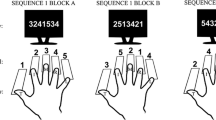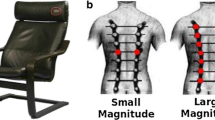Summary
This study investigated the relative importance of perceptual and motor factors in the imitation of simple temporal patterns. Previous research in which subjects tap out interval sequences using one finger has suggested that perceptual factors play an important role in response timing. Studies of bimanual tapping, in contrast, stress the importance of motor interactions between the two hands. In this experiment we compared the ability of subjects to tap out two-interval sequences using one finger, two fingers on one hand, and two fingers on opposite hands. The results showed almost identical performance under the three response conditions. It is suggested that the perceptual relations between intervals in a pattern were the main determinant of performance in this experiment.
Similar content being viewed by others
References
Essens, P. J., & Povel D. J. (1985). Metrical and non-metrical representations of temporal patterns. Perception & Psychophysics, 37, 1–7.
Fraisse, P. (1946). Contribution a l'étude du rhythme en tant que forme temporelle. Journal de Psychologie Normale et Pathologique, 39, 283–304.
Fraisse, P. (1956). Les structures rhythmiques. Louvain: Presses Universitaires de Louvain.
Greeno, J. G., & Simon, H. A. (1974). Processes for sequence production. Psychological Review, 81, 187–198.
Keele, S. W., Pokorny, R. A., Corcos, D. M., & Ivry, R. (1985). Do perception and motor production share common timing mechanisms? A correlational analysis. Acta Psychologica, 60, 173–191.
Kelso, J. A. S., Holt, K. G., Rubin, P., & Kugler, P. N. (1981). Patterns of human interlimb coordination emerge from the properties of non-linear, limit cycle oscillatory processes: Theory and data. Journal of Motor Behavior, 5, 229–238.
Klapp, S. T., Hill, M. D., Tyler, J. G., Martin, Z. E., Jagacinski, R. J., & Jones, M. R. (1985). On marching to two different drummers: Perceptual aspects of the difficulties. Journal of Experimental Psychology: Human Perception and Performance, 11, 814–827.
Kolers, P. A., & Brewster, J. M. (1985). Rhythms and responses. Journal of Experimental Psychology: Human Perception and Performance, 11, 150–167.
Povel, D. J. (1981). Internal representation of simple temporal patterns. Journal of Experimental Psychology: Human Perception and Performance, 7, 3–18.
Summers, J. J., Hawkins, S. R., & Mayers, H. (1986). Imitation and production of interval ratios. Perception & Psychophysics, 39, 437–444.
Yamanishi, J., Kawato, M., & Suzuki, R. (1979). Studies of human finger tapping neural networks by phase transition curves. Biological Cybernetics, 33, 199–208.
Yamanishi, J., Kawato, M., & Suzuki, R. (1980). Two coupled oscillators as a model for the coordinated finger tapping by both hands. Biological Cybernetics, 37, 219–225.
Author information
Authors and Affiliations
Rights and permissions
About this article
Cite this article
Summers, J.J., Bell, R. & Burns, B.D. Perceptual and motor factors in the imitation of simple temporal patterns. Psychol Res 51, 23–27 (1989). https://doi.org/10.1007/BF00309272
Received:
Issue Date:
DOI: https://doi.org/10.1007/BF00309272




